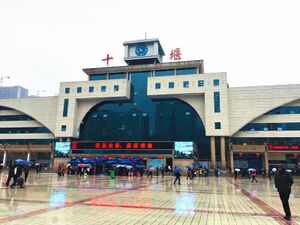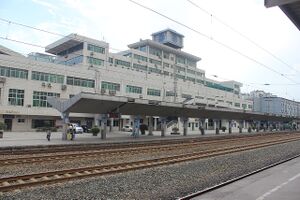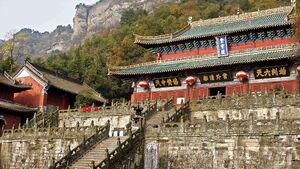
Shiyan
| Shiyan | |||||
|---|---|---|---|---|---|
| Japanese Name | シーイェン | ||||
| Weapon | |||||
| Race | Human | ||||
| Nationality | |||||
| Birthday | November 24 | ||||
| Constellation | Sagittarius | ||||
| Talents | Fetching water, Breaking roof tiles | ||||
| Likes | Physical activities | ||||
| Dislikes | Classroom learning | ||||
| Strengths | Unafraid of strong enemies, Doesn't lie | ||||
| Weaknesses | Lacking in common sense | ||||
| Hobbies | Training, Reading manhua that Beijing recommends | ||||
I'm Shiyan. I belong to the Eisengrad Central Army division. I try and shy away from being called a soldier. I'm a martial artist raised in the Wudang Mountains. I'm always itching to fight someone stronger than me. I'll take anyone on that wants to spar, so don't hesitate to ask!
Layers
| Icon | Title | Release Date | Where to Obtain |
|---|---|---|---|
| [Power-Hungry Martial Artist] Shiyan | 2021 October 23 | [The Bizarre Lady and the Immovable Sorceress] Limited Gacha | |
| [Venturing Into the Outside World] Shiyan | 2021 October 15 | [Warm Welcome! Battle Girl's Extreme Cram School!] Event Reward | |
| [Martial Artist, Learns Etiquette] Shiyan | 2023 October 13 | [Tokimeki Date Memorial] Pick Up Gacha, Premium Gacha | |
| [Place to Return Post-Training] Shiyan | 2021 October 15 | [Warm Welcome! Battle Girl's Extreme Cram School!] Pick Up Gacha, Premium Gacha |
Skills
Trivia
- Shiyan's birthday is the founding date of of Shiyan City in 1969.
- Wudang Mountain is the sacred place of Taoism and is considered to be the birthplace of the Chinese Wudang martial arts school (Taijiquan, Xingyiquan, etc).
- Shiyan's martial arts rival is Tianjin, practitioner of Shaolin martial arts, mirroring the status of the two schools in real life.
- Breaking is a martial arts technique that is used in competition, demonstration and testing, where a martial artist uses a striking surface to break one or more objects using the skills honed in their art form. The most common object is a piece of wood or brick, though it is also common to break cinder blocks, glass, or even a piece of metal such as steel bars.
- The building in the background of [Place to Return Post-Training] is the Zixiao Palace of the Wudang Mountains Taoist complex in the northwestern part of Hubei, China.
Counterpart
Shiyan Station (十堰站; pinyin: Shíyàn zhàn) is a train station located in Shiyan City, Hubei Province, built in 1970 as the Xiangyu Railway reached Shiyan City. The station is fully electrified and is 166 km away from Xiangyang Station. It belongs to Shiyan section of Wuhan Railway Bureau and is a Category-1 station. The construction of Shiyan Station started in 1971 and was put into use from October 1, 1976 onwards. At that time of its completion, the station building was a two-story brick and concrete structure with an area of 6150 square meters, and was a Category-3 intermediate station. The waiting room had an area of 957 square meters and could accommodate more than 1500 passengers.
In 1989, Shiyan Station was upgraded to Category-2 station. Reconstruction of Shiyan station began on June 1999, where the almost 20-year-old station building was demolished and a new station building was built at the same time. The new station building was put into use in September 2003. Another renovation happened in 2009: the project included the renovation of station facilities to accommodate the operation of trains on the existing Xiangyu line, as well as the construction of new luggage channels. The station began a large-scale renovation in 2014 with the construction of a new north station house and the renovation of the existing station yard, officially opened later on 31 January 2019. In the event of the 2019 coronavirus disease outbreak in Hubei Province, the station was closed for passenger operations from 20:00 on January 26, 2020 and resumed on March 25. In the second half of 2020, the local government of Shiyan carried out renovation works on the South Square bus station.
Shiyan North Station House was opened in February 2019 and is an underground station house. The north station building has three levels: ground level, first underground level and second underground level, of which the ground level is the north square; the first underground level contains the ticket hall and waiting hall with four waiting areas, which are connected to each platform of the station through the inbound flyover. The second basement level is reserved for the exit and bus station.
Shiyan South Station House was put into use in 2003, with an area of 15,760 square meters and a height of 27 meters, and is only used to make stations. The station building is designed with the symbolic meaning of "spreading wings to soar", and the façade's iconic "W" shape represents the initials of "Welcome" in English. The ticket office in the south station building is located in the east wing of the station building, with 13 self-service ticket machines and 8 ticket windows. The entrance is located in the middle of the station building, and Shiyan Station has two waiting rooms: the first waiting room is located on the second floor of the station building, and the second waiting room is located on the second floor of the station building; in addition, there is a soft-seat waiting room.Wikipedia
The Wudang Mountains (武当山/武當山; pinyin: Wǔdāng Shān) consist of a mountain range in the northwestern part of Hubei, China, just south of Shiyan. They are home to a famous complex of Taoist temples and monasteries associated with the Lord of the North, Xuantian Shangdi. The Wudang Mountains are renowned for the practice of Tai chi and Taoism as the Taoist counterpart to the Shaolin Monastery, which is affiliated with Chinese Chán Buddhism. The Wudang Mountains are one of the "Four Sacred Mountains of Taoism" in China, an important destination for Taoist pilgrimages. The monasteries such as the Wudang Garden were made a UNESCO World Heritage Site in 1994 because of their religious significance and architectural achievement.
For centuries, the mountains of Wudang have been known as an important center of Taoism, especially famous for its Taoist versions of martial arts or Taichi. The first site of worship—the Five Dragons Temple—was constructed at the behest of Emperor Taizong of Tang. Further structures were added during the Song and Yuan dynasties, while the largest complex on the mountain was built during the Ming dynasty (14th–17th centuries) as the Yongle Emperor claimed to enjoy the protection of the god Beidi or Xuantian Shangdi. During the Ming Dynasty, 9 palaces, 9 monasteries, 36 nunneries and 72 temples were located at the site. Temples regularly had to be rebuilt, and not all survived; the oldest existing structures are the Golden Hall and the Ancient Bronze Shrine, made in 1307. Other noted structures include Nanyang Palace (built in 1285–1310 and extended in 1312), the stone-walled Forbidden City of the Taihe Palace at the peak (built in 1419), and the Purple Cloud Temple (built in 1119–1126, rebuilt in 1413 and extended in 1803–1820). Today, 53 ancient buildings still survive.
At the first national martial arts tournament organized by the Central Guoshu Institute in 1928, participants were separated into practitioners of Shaolin and Wudang styles. Styles considered to belong to the latter group called Wudangquan are those with a strong element of Taoist neidan exercises. Typical examples of Wudangquan are Taijiquan, Xingyiquan and Baguazhang. According to legend, Taijiquan was created by the Taoist hermit sage Zhang Sanfeng, who lived in the Wudang mountains. Wudangquan has been partly reformed to fit the PRC sport and health promotion program. The third biannual Traditional Wushu Festival was held in the Wudang Mountains from October 28 to November 2, 2008. Wikipedia
Map
Gallery
- Pages using Tabber parser tag
- Pages using DynamicPageList3 parser tag
- Weapon Gauntlet
- Human
- Eisengrad
- Sagittarius
- Element Blow
- Element Fire
- Element Wind
- Element Water
- Train Knights
- China













